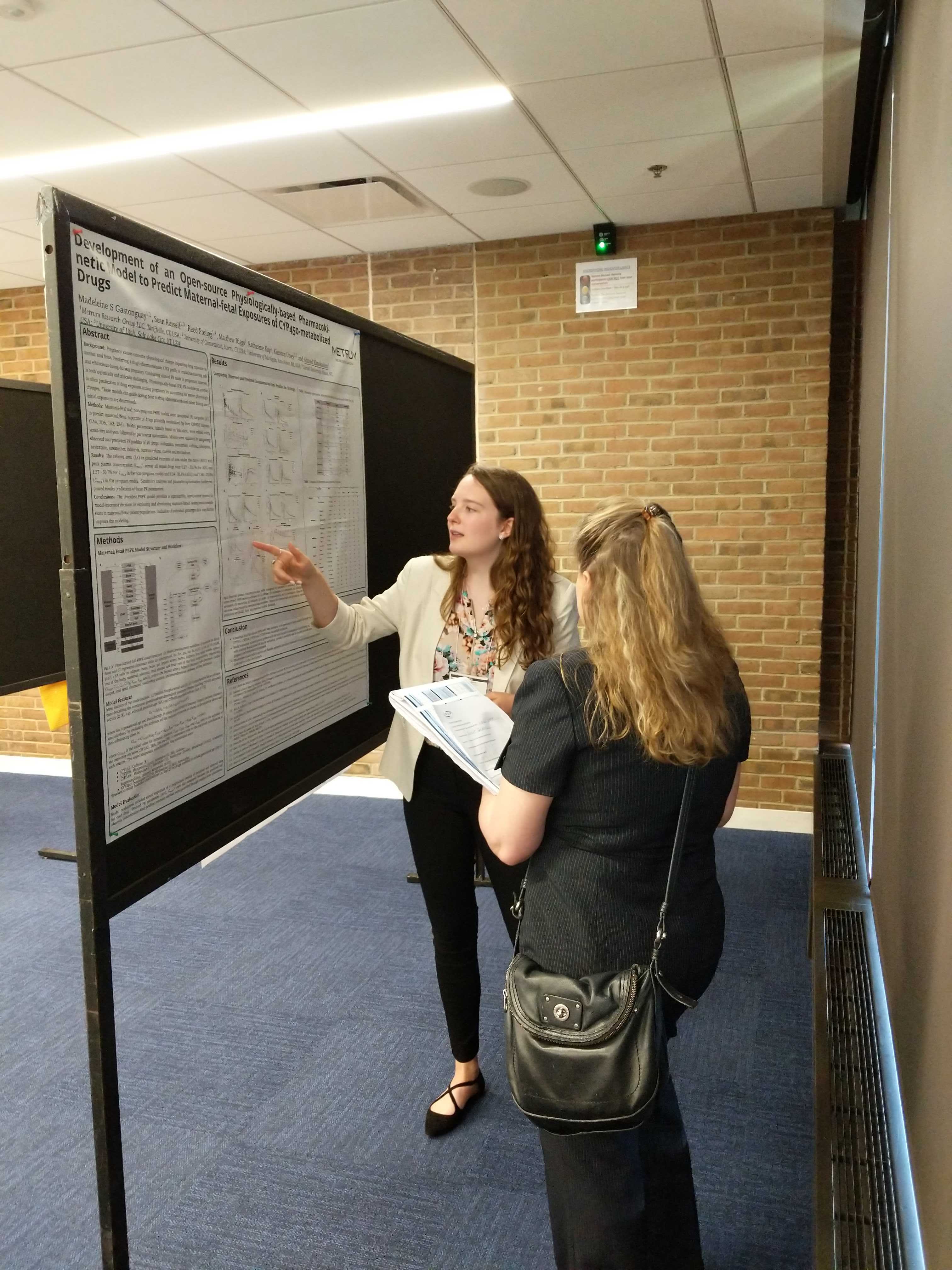“Don’t concern yourself with being the best. Instead, focus on doing your best and the rest will fall into place.”
It was 29 years ago today that my advisor, Sorell Schwartz, shared those words of wisdom with me upon the successful defense of my doctoral dissertation at Georgetown University. I am not sure that I completely understood the nuance of the message at that time, but years of experience and perspective have been enlightening. I’ve learned that a focus on doing your best is a powerful and liberating approach to science, business, and life in general.
The 29 years that followed were characterized by my best efforts to pursue the advocacy, growth, and application of the science of pharmacometrics in the fight against disease. In that time, my path wandered across experiences at the FDA, academia, a non-profit, and 3 different start-ups, including the last 18+ years leading Metrum Research Group… all at full speed and full intensity.
After nearly three decades of this sort of career intensity, it is time for me to slow down a bit and spend more time with my family and on other interests in my life. It’s also time to empower others around me to do their best. That is why, today, I am stepping down from the role of CEO at MetrumRG, and Michelle Johnson begins an exciting new journey as our incoming chief executive (https://news.metrumrg.com/press-release-2022-10).
A focus on doing your best is well aligned with the pursuit of a meaningful purpose and an impact that reaches far beyond any one individual, whereas a focus on being the best often becomes the purpose itself. Doing your best encourages a perspective of team vs. self, it emphasizes collaboration vs. competition, it allows for the priority to be impactful work vs. an ambitious assessment of standing.
It is in that spirit that Jeff Hane and I founded Metrum Research Group in 2004 as a company with a mission to improve health and defeat disease. The idea was to build a team of expert quantitative scientists, support them with leading-edge technology and business infrastructure, and empower the team to do their best… growing the science in our community and delivering high quality services to our biomedical industry partners. Of course, we intended to do all of this while creating a great place to work, too.
As with any business, there were challenges along the way with plenty of opportunities to learn and improve. As our team evolved and innovated, we learned of the tremendous potential for open science (open source software, open models, open courseware) to grow the community, our sphere of influence, and the market itself, sharing knowledge openly and creating opportunities for our business and the entire sector. We recognized the incredible synergy between quantitative sciences and emerging technologies, becoming the first in our industry to fully embrace high-performance cloud computing and ultimately creating a technology solutions business unit to complement our quantitative science services. Most importantly, we learned that our people are the most essential element of our business and we aimed to create a culture of empathy, transparency, trust, kindness, inclusion, and service to others.
Over the past few years, I’ve come to understand that doing my best as CEO of MetrumRG means doing everything I can to prepare our team and company for the future success of our mission, even if that means stepping aside so that others will have a greater opportunity to grow and rise to the challenge of doing their best.
It is, therefore, with full trust and confidence that I have asked Michelle Johnson to lead the next phase of the MetrumRG journey as our new Chief Executive Officer. As our Chief Operating Officer, Michelle was exceptional, demonstrating invaluable leadership skills and a strong understanding of our mission and culture. Michelle led business operations functions, was responsible for oversight of our finances, and created lasting relationships with our staff, our partners, and other stakeholders. As part of our executive team, she was an instrumental voice in every key business decision during her tenure. I know that Michelle is committed to the continued pursuit of the MetrumRG mission and founding principles and I’m excited to see how she will apply her unique talents, skills, and vision to the leadership of our company.
The company has never been in a better position to embrace the tremendous potential for quantitative sciences and technology in the biomedical industry. Michelle and our executive team, Bill Knebel, Matt Riggs and Joydeep Bhattacharyya, form a unified partnership, each bringing individual skills and knowledge that combine to form a solid foundation for the future of MetrumRG. Together they empower our team of expert scientists, service-driven operations staff, and innovative technology engineers to do their best work. I am confident that our team is as ready as ever to continue engaging in strong collaborations with our customers and community and to deliver lasting impact on patients’ lives.
My journey with MetrumRG has been incredibly rewarding. I thank God for this experience and for all the amazing people who have contributed along the way. I am grateful to our families, our employees past and present, our customers and business partners, academic collaborators and trainees, colleagues in regulatory agencies, and all the passionate scientists and engineers in our community. Your guidance, trust, loyalty, partnership, support, and friendship have enabled MetrumRG to make a difference and we look forward to your continued alliance long into the future.
It is truly a blessing to be able to turn over leadership of the company on my own terms at a time when MetrumRG’s future is incredibly bright. The mission to defeat disease is still unfulfilled and it will be my privilege to serve Michelle and the executive team in an advisory role on the board of directors as they continue the important work of MetrumRG. This will be new territory for me and I am committed to doing my best.
Marc Gastonguay
Recent Posts
Topics: Metrum News
Proposal for an Open Software Development Life Cycle
The confluence of several factors, including: the growing recognition of the value of quantitative approaches to decision-making in drug development, advancements in numerical methods and analytics, and democratization of modern software engineering, has led to the emergence of multiple pharmacometrics-related software tools, both commercially and publicly licensed. A rigorously managed, high-quality, software development practice is central to reliable and reproducible scientific application and regulatory compliance for these tools. Professional software development best practices should typically be outlined in a Software Development Life Cycle (SDLC) policy or procedure, but the extent of guidance, consistency of methods, adherence to procedures, completeness of quality documentation, and execution rigor vary greatly across software development organizations or teams.
Metrum Research Group scientists participated in the first International Society of Pharmacometrics (ISoP) Regional Quantitative Systems Pharmacology (QSP) Day on July 16, 2019.
The meeting, which included podium presentations, a poster session, and opportunities for discussion and networking, highlighted several examples of the application of QSP methods in drug development. Particularly notable topics included: the integration of transcriptomics and systems pharmacology models, challenges with calibration of virtual patients in QSP models, and the use of QSP as a scaffold for bridging from well studied therapeutic indications to related but somewhat less understood indications.
Madeleine Gastonguay, of MetrumRG and University of Connecticut, presented the poster "Development of an open-source physiologically-based pharmacokinetic model to predict maternal-fetal exposures of CYP450-metabolized drugs". The open science philosophy, exemplified in this work, resonated with attendees and was also highlighted by several of the conference speakers.
Special thanks goes to the meeting organizers, the ISoP QSP Special Interest Group (ISoP QSP SIG), and hosts, Bristol-Myers Squibb (BMS), for a well organized event and an energizing, thought-provoking day.
Pictures from the event below.
Marc R. Gastonguay, Ph.D., awarded 2018 Bristol-Myers Squibb Mentorship in Clinical Pharmacology Award
The following is a transcription of Dr. Gastonguay's acceptance speech when presented with the 2018 Bristol-Myers Squibb Mentorship in Clinical Pharmacology Award at the American College of Clinical Pharmacology on September 24, 2018.
Open Science: A Key to the Future Growth of Clinical Pharmacology.
Topics: Open Science
Slides available: Neighbor’s Envy Owner’s Pride – Comparator Analysis for Drug Development and Market Access
Slides presented by Dr. Marc Gastonguay at ACoP8 can be found here.
Slides available: Points to Consider when Making Inferences about Covariates
Topics: Open Science
Theory, Empiricism, and a Vision for the Continued Growth of Pharmacometrics
Slides Available: Dr. Marc Gastonguay's Sheiner Award lecture presented at ACoP8 on October 15, 2017. GastonguayISoPSheinerLecture2017final
Topics: Open Science
Rare Disease Day 2014: Orphan Drug Trial Design and Analysis
In recognition and support of Rare Disease Day, 2014, the scientists and staff at Metrum Research Group have focused the weekly journal club on articles related to this topic, for the month of February…
Though deemed “rare”, approximately 25—30 million Americans, and 300 million people worldwide, have been diagnosed with one of >6,800 known rare diseases. An estimated 50% of those affected are children. The prevalence of individual rare diseases can range from dozens in the US (progeria, hypophosphatasia, Niemann-Pick, for example), to thousands globally (such as, Crohn’s disease and cystic fibrosis). Although traditionally considered impractical for big pharma development, innovation and development of therapeutics for rare diseases have led to promising treatments for some diseases in recent decades. In the period of time from the passage of the Orphan Drug Act of 1983 until May 2010, the FDA approved 353 orphan drugs and granted orphan designations to 2,116 compounds. As of 2010, at 200 orphan diseases have become treatable (Armstrong). Still, rare diseases pose a critical unmet medical need.
Topics: Rare Disorders



